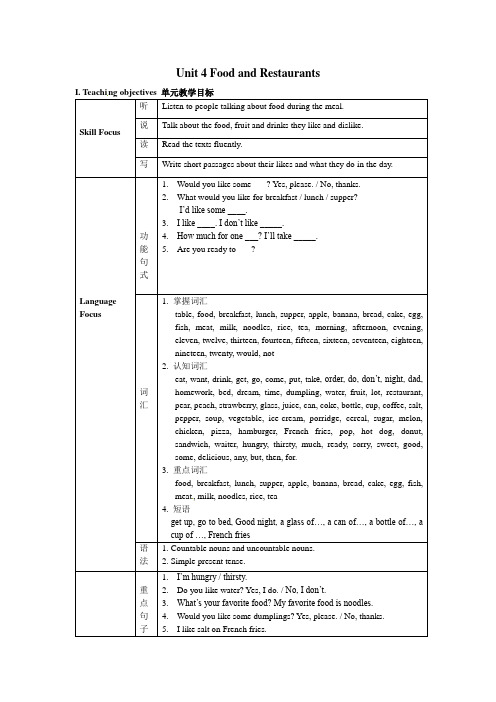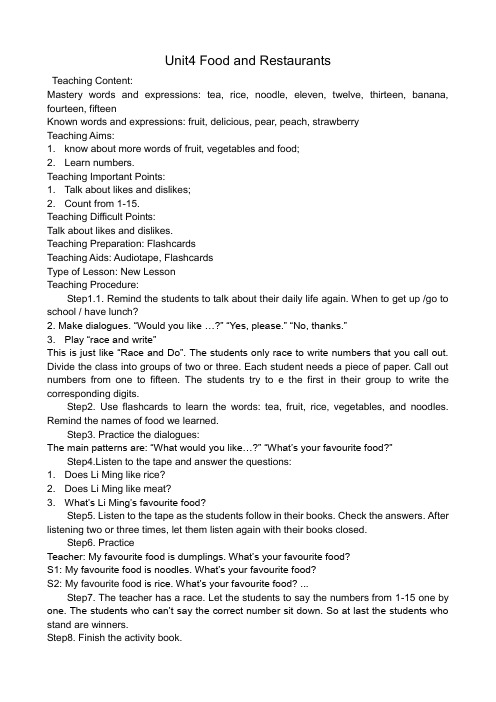初中英语最新-七年级英语Food and Restaurants教案4 精品
- 格式:doc
- 大小:21.04 KB
- 文档页数:3

冀教版英语七上Unit 4《Food and Restaurants》(Lessons 19、20)教学设计一. 教材分析冀教版英语七上Unit 4《Food and Restaurants》主要介绍了食物和餐厅的相关话题。
本单元包括两个课时,分别是Lessons 19和Lessons 20。
本单元的学习内容紧紧围绕食物和餐厅这两个主题展开,通过学习本单元,学生能够掌握一些关于食物和餐厅的词汇和表达方式,以及如何用英语进行点餐。
二. 学情分析在学习本单元之前,学生已经掌握了一些基本的英语语法和词汇知识,能够进行简单的英语交流。
但是,对于一些关于食物和餐厅的专业词汇和表达方式,学生可能比较陌生。
此外,学生可能对如何用英语进行点餐的情境较为陌生,需要通过实例和角色扮演等方式进行操练。
三. 教学目标1.学生能够掌握关于食物和餐厅的词汇和表达方式。
2.学生能够用英语进行点餐,并能够用英语描述自己喜欢的食物和餐厅。
3.学生能够在日常生活中运用所学的知识和技能,提高自己的英语实际应用能力。
四. 教学重难点1.重点:学生能够掌握关于食物和餐厅的词汇和表达方式,以及如何用英语进行点餐。
2.难点:学生能够用英语描述自己喜欢的食物和餐厅,以及能够在日常生活中运用所学的知识和技能。
五. 教学方法1.情境教学法:通过模拟餐厅情境,让学生在实际情境中学习和运用所学的知识和技能。
2.交际教学法:通过学生之间的互动和交流,提高学生的英语口语表达能力和交际能力。
3.任务型教学法:通过完成各种任务,激发学生的学习兴趣和积极性,提高学生的学习效果。
六. 教学准备1.教学材料:冀教版英语七上教材,多媒体教学设备。
2.教学辅助材料:食物和餐厅的图片、卡片,角色扮演道具等。
七. 教学过程1.导入(5分钟)通过展示一些食物和餐厅的图片,引导学生谈论他们喜欢的食物和餐厅,激发学生的学习兴趣。
2.呈现(10分钟)教师通过展示冀教版英语七上教材中的图片和文字,向学生介绍本节课的主要内容和知识点,包括食物和餐厅的词汇和表达方式,以及如何用英语进行点餐。

Unit 4 Food and Restaurants I. Teaching objectives 单元教学目标Skill Focus 听Listen to people talking about food during the meal.说Talk about the food, fruit and drinks they like and dislike.读Read the texts fluently.写Write short passages about their likes and what they do in the day.Language Focus 功能句式1.Would you like some ___? Yes, please. / No, thanks.2.What would you like for breakfast / lunch / supper?I’d like some ____.3.I like ____. I don’t like _____.4.How much for one ___? I’ll take _____.5.Are you ready to ___?词汇1. 掌握词汇table, food, breakfast, lunch, supper, apple, banana, bread, cake, egg,fish, meat, milk, noodles, rice, tea, morning, afternoon, evening,eleven, twelve, thirteen, fourteen, fifteen, sixteen, seventeen, eighteen,nineteen, twenty, would, not2. 认知词汇eat, want, drink, get, go, come, put, tak e, order, do, don’t, night, dad,homework, bed, dream, time, dumpling, water, fruit, lot, restaurant,pear, peach, strawberry, glass, juice, can, coke, bottle, cup, coffee, salt,pepper, soup, vegetable, ice-cream, porridge, cereal, sugar, melon,chicken, pizza, hamburger, French fries, pop, hot dog, donut,sandwich, waiter, hungry, thirsty, much, ready, sorry, sweet, good,some, delicious, any, but, then, for.3. 重点词汇food, breakfast, lunch, supper, apple, banana, bread, cake, egg, fish,meat, milk, noodles, rice, tea4. 短语get up, go to bed, Good night, a glass of…, a can of…, a bottle of…, acup of …, French fries语法1. Countable nouns and uncountable nouns.2. Simple present tense.重点句子1.I’m hungry / thirsty.2.Do you like water? Yes, I do. / No, I don’t.3.What’s your favorite food? My favorite food is noodles.4.Would you like some dumplings? Yes, please. / No, thanks.5.I like salt on French fries.II. Teaching materials analyzing 教材分析1. 教材分析通过本单元学习,帮助学生掌握一日三餐的表达法,英语国家中最常见的饮料与食品的名称,了解一些西方饮食习惯并能用简单的英语在就餐时进行交谈。

冀教版英语七上Unit 4《Food and Restaurants》全单元教学设计一. 教材分析冀教版英语七上Unit 4《Food and Restaurants》以食物和餐厅为主题,通过介绍各种食物和餐厅的相关词汇、句型和语法,让学生学会表达自己对食物和餐厅的看法。
本单元包括两个听说读写任务,分别是讨论最喜欢的食物和餐厅以及写一封推荐信。
教材内容丰富,贴近生活,有利于激发学生的学习兴趣和参与积极性。
二. 学情分析七年级的学生已经掌握了基本的英语语法和词汇,具备一定的听说读写能力。
他们对食物和餐厅这一主题比较感兴趣,容易产生共鸣。
但部分学生可能在口语表达和写作方面还存在一定的困难,需要教师在教学中给予关注和指导。
三. 教学目标1.知识目标:学生能够掌握本单元所学的词汇、句型和语法,正确运用它们进行口头和书面表达。
2.能力目标:学生能够在实际情境中运用本单元所学内容进行交流,提高听说读写能力。
3.情感目标:学生能够培养对食物的兴趣,学会欣赏和分享美食文化。
四. 教学重难点1.重点:本单元的词汇、句型和语法。
2.难点:如何运用所学内容进行实际交流和写作。
五. 教学方法1.任务型教学法:通过设定各种真实的任务,让学生在完成任务的过程中运用所学知识。
2.情境教学法:创设各种与食物和餐厅相关的情境,激发学生的学习兴趣和参与积极性。
3.合作学习法:鼓励学生之间进行互动交流,共同完成学习任务。
六. 教学准备1.教学材料:教材、多媒体课件、食物和餐厅的图片、卡片等。
2.教学设备:投影仪、计算机、音响等。
七. 教学过程1.导入(5分钟)利用食物和餐厅的图片,引导学生谈论他们最喜欢的食物和餐厅,激发学生的学习兴趣。
2.呈现(10分钟)展示本节课的主要内容,包括词汇、句型和语法。
通过图片、卡片等形式,让学生直观地感知和学习新知识。
3.操练(10分钟)分组进行角色扮演,模拟在餐厅的场景,让学生运用所学词汇和句型进行实际交流。

Unit4 Food and RestaurantsTeaching Content:Mastery words and expressions: tea, rice, noodle, eleven, twelve, thirteen, banana, fourteen, fifteenKnown words and expressions: fruit, delicious, pear, peach, strawberryTeaching Aims:1. know about more words of fruit, vegetables and food;2. Learn numbers.Teaching Important Points:1. Talk about likes and dislikes;2. Count from 1-15.Teaching Difficult Points:Talk about likes and dislikes.Teaching Preparation: FlashcardsTeaching Aids: Audiotape, FlashcardsType of Lesson: New LessonTeaching Procedure:Step1.1. Remind the students to talk about their daily life again. When to get up /go to school / have lunch?2. Make dialogues. “Would you like …?” “Yes, please.” “No, thanks.”3. Play “race and write”This is just like “Race and Do”. The students only race to write numbers that you call out. Divide the class into groups of two or three. Each student needs a piece of paper. Call out numbers from one to fifteen. The students try to e the first in their group to write the corresponding digits.Step2. Use flashcards to learn the words: tea, fruit, rice, vegetables, and noodles. Remind the names of food we learned.Step3. Practice the dialogues:The main patterns are: “What would you like…?” “What’s your favourite food?”Step4.Listen to the tape and answer the questions:1. Does Li Ming like rice?2. Does Li Ming like meat?3. What’s Li Ming’s favourite food?Step5. Listen to the tape as the students follow in their books. Check the answers. After listening two or three times, let them listen again with their books closed.Step6. PracticeTeacher: My favourite food is dumplings. What’s your favourite food?S1: My favourite food is noodles. What’s your favourite food?S2: My favourite foo d is rice. What’s your favourite food? ...Step7. The teacher has a race. Let the students to say the numbers from 1-15 one by one. The students who can’t say the correct number sit down. So at last the students who stand are winners.Step8. Finish the activity book.SummaryTalking about likes and dislikes is familiar to the students. The numbers from 11-15 are so long words. So spend more time on the numbers.Lesson 28: What’s for Breakfast?Teaching Content:Mastery words and expressions: milk, cake, egg, breadKnown words and expressions: ice cream, cereal, porridge, put, sugarTeaching Aims:1. Know about the food and drink habits in western countries.2. The similarities and differences between China and Canada in the daily life.Teaching Important Points:1. Learn more words about food in China and western countries.2. People in different countries have different food for breakfast.Teaching Difficult Points:Patterns:1. Time for breakfast.2. I’d like porridge for breakfast.3. I put milk and sugar on it.Teaching Preparation: FlashcardsTeaching Aids: Audiotape, FlashcardsType of Lesson: New lessonTeaching Procedure:Step1.1. Remind the students to count the numbers from 1-15.2 .Let’s have a short dictation about the numbers.Step2. Use flashcards or drawings to show the food to the students. At the same time, ask questions: “Do you like this?” “Yes, I do.” “No, I don’t. I like…”Step3. Drill:Point to pictures. Teacher asks questions. Let students answer. Then the next students do this one by one.Teacher: Do you like this?S1: Yes, I do.S2: Do you like this?S3: No, I don’t. I like rice. Rice is okay. …Step4.Listen to the tape and imitate after it for several times until they can read it correctly and fluently.Step5 L isten to Part2 “Porridge or Cereal”. Answer the following questions.1. What are Li Ming and Jenny doing?2. What would Li Ming like for breakfast?3. What does Jenny put in the cereal?Step5 Read the text loudly and check the answers. If they can’t understand “Porridgeor Cereal”, the teacher uses the pictures to help them catch the meaning.Step6.Listen again and try to imitate after it. After a while, they can repeat with their books closed.Step7. Read the dialogues aloud in roles on pairs. Then change the roles, practice again.Step8. Ask several volunteers to come to the front and act the dialogue out.Step9. 1 Finish off the activity book.1. Make up new dialogues according to the text.SummarySome patterns are difficult for students to understand. So practice is the key to grasp them.。

Unit 4 Food and RestaurantsLesson 21 At the Market【教学目标】(1)能够听、说、读、写单词:market, cabbage, pear, watermelon, carrot, grape, sweet。
(2)掌握和介绍一些水果和蔬菜的重点词汇, 用所学英语句型询问对方所喜欢的蔬菜和水果。
(3)能够听、说、运用句型:①Li Ming takes Jack to the morning market. ②Do you like fruit and vegetables? ③Potatoes are my favourite. ④Yes, I like vegetables very much.(4)能够用正确的语音、语调朗读课文中的对话, 能运用所学知识与他人问候交流,进行英语日常交际。
【教学重难点】重点:能够听、说、读、写单词:market, cabbage, pear, watermelon, carrot, grape, sweet。
难点:用所学英语句型询问对方所喜欢的蔬菜和水果。
句型:①Li Ming takes Jack to the morning market. ②Do you like fruit and vegetables? ③Potatoes are my favourite. ④Yes, I like vegetables very much.【教学方法】情景导入法、活动探究法。
【教学过程】新课导入:1. Let’s Review!复习上一课所学过的单词。
tomatoes, potatoes, strawberries, bread, milk2. 新课导入: 播放歌曲Let’s enjoy a song!学生跟唱歌曲,引入本课的学习内容。
新课讲授:Step 1 New words and expression.(1) market [’mɑ:kit]We can buy some fruit at the market.(2) pearsDo you like pears?(3) watermelonsWatermelons are my favorite fruit.(4) grapesDo you like grapes?(5) carrotsI don’t like to eat carrots.(6) cabbagesI want to eat cabbages.(7) sweetI like to eat ice cream, it is sweet.通过单词游戏,引出要学习的新知,引起学生的兴趣,然后利用学生的迁移能力,引导学生自读单词,培养学生的思维能力。

冀教版英语七上Unit 4《Food and Restaurants》(Lessons 22-24)教学设计一. 教材分析冀教版英语七上Unit 4《Food and Restaurants》主要介绍了食物和餐厅的相关知识。
本单元包括24个单词和6个句子,主要围绕着食物名称、餐厅名称、点餐、用餐等场景展开。
通过本单元的学习,学生能够掌握食物和餐厅的英语表达,以及简单的点餐用语。
二. 学情分析七年级的学生已经具备了一定的英语基础,能够听懂并运用一些基本的英语口语。
但是,对于食物和餐厅的相关词汇和句子,学生可能比较陌生。
因此,在教学过程中,需要引导学生通过已有的知识体系来构建新的知识结构。
三. 教学目标1.学生能够听懂、说对食物和餐厅的英语表达。
2.学生能够运用所学的点餐用语,进行简单的餐厅点餐场景模拟。
3.学生能够通过本单元的学习,提高自己的英语口语表达能力。
四. 教学重难点1.食物和餐厅相关词汇的记忆和运用。
2.点餐用语的掌握和运用。
五. 教学方法采用任务型教学法,通过创设餐厅场景,让学生在实际操作中学习并运用食物和餐厅的英语表达,以及点餐用语。
六. 教学准备1.准备食物和餐厅的图片,用于展示和教学。
2.准备餐厅点餐的场景,让学生进行实际操作。
3.准备食物和餐厅的单词卡片,用于记忆和复习。
七. 教学过程1.导入(5分钟)通过展示食物和餐厅的图片,引导学生说出自己喜欢的食物和餐厅,从而引出本课的主题。
2.呈现(10分钟)教师展示食物和餐厅的单词卡片,引导学生学习并朗读。
然后,教师呈现点餐的场景,让学生听懂并模仿。
3.操练(10分钟)学生分成小组,每组模拟一个餐厅,进行点餐和用餐的对话。
教师巡回指导,纠正学生的发音和用词错误。
4.巩固(10分钟)教师挑选几组学生,让他们在班上进行点餐和用餐的对话表演。
其他学生听后,进行评价和反馈。
5.拓展(10分钟)教师引导学生思考:如何用英语描述自己喜欢的餐厅?学生分组讨论,并向全班分享自己的观点。
冀教版英语七上Unit 4《Food and Restaurants》(Lessons 19-21)教学设计一. 教材分析冀教版英语七上Unit 4《Food and Restaurants》主要介绍了食物和餐厅的相关知识。
本单元包括Lessons 19-21,话题围绕食物和餐厅展开,通过学习本单元,学生能够掌握描述食物和餐厅的词汇和句型,学会在餐厅点餐和交流。
教材内容贴近学生生活,激发学生学习兴趣,同时培养学生的语言运用能力和跨文化交际意识。
二. 学情分析七年级的学生已经掌握了基本的英语语法和词汇,具备一定的听说读写能力。
但学生在实际运用英语进行交流时,仍存在一定的困难。
针对这一特点,教师在教学过程中要注重激发学生的学习兴趣,创设真实的学习情境,让学生在实践中提高英语运用能力。
此外,学生对美食和餐厅有一定的兴趣,可以利用这一点激发学生的学习积极性。
三. 教学目标1.知识目标:–掌握描述食物和餐厅的词汇和句型。
–学会在餐厅点餐和交流。
2.能力目标:–提高学生的听说读写能力,尤其是口语表达能力。
–培养学生的跨文化交际意识。
3.情感目标:–激发学生对英语学习的兴趣。
–培养学生的团队协作能力和自主学习能力。
四. 教学重难点•描述食物和餐厅的词汇和句型。
•在餐厅点餐和交流的交际用语。
•运用所学词汇和句型进行实际交流。
•理解并运用餐厅相关的交际用语。
五. 教学方法1.情境教学法:通过创设真实的餐厅场景,让学生在实践中学习并运用所学知识。
2.交际法:鼓励学生进行角色扮演,模拟在餐厅点餐和交流的情景,提高学生的口语表达能力。
3.任务型教学法:通过完成各种任务,激发学生的学习兴趣,培养学生的团队协作能力。
4.启发式教学法:教师引导学生思考,激发学生的学习积极性,提高学生的自主学习能力。
六. 教学准备1.教学素材:教材、多媒体课件、图片、实物等。
2.教学工具:投影仪、计算机、录音机、黑板等。
3.教学环境:宽敞的教室,便于学生进行实践活动。
冀教版英语七上Unit 4《Food and Restaurants》(Lessons 21、22)教学设计一. 教材分析冀教版英语七上Unit 4《Food and Restaurants》(Lessons 21、22)主要介绍了食物和餐厅的相关知识。
本单元通过谈论不同国家的美食和餐厅,让学生学会如何描述食物和餐厅,并能够进行简单的餐厅点餐对话。
教材内容丰富,包括词汇、对话、阅读理解和任务型活动等,旨在提高学生的听说读写技能,培养他们的跨文化交际能力。
二. 学情分析学生在学习本单元前已经掌握了基本的英语语法和词汇,具备一定的听说读写能力。
但部分学生对英语学习兴趣不高,缺乏积极性;部分学生胆子较小,不敢开口说英语。
此外,学生对外国美食和餐厅的了解有限,可能存在文化差异带来的学习障碍。
三. 教学目标1.知识目标:学生能够掌握本单元的词汇和句型,了解不同国家的美食和餐厅文化。
2.技能目标:学生能够在真实情境中运用所学知识进行简单的餐厅点餐对话,提高听说读写技能。
3.情感目标:激发学生对英语学习的兴趣,培养他们积极向上的学习态度,增强跨文化交际意识。
四. 教学重难点1.重点:本单元的词汇、句型和餐厅点餐对话。
2.难点:对外国美食和餐厅文化的理解,以及如何在实际情境中运用所学知识。
五. 教学方法1.任务型教学法:通过设置真实的任务,让学生在完成任务的过程中运用所学知识,提高实际运用能力。
2.情境教学法:创设生动有趣的场景,激发学生的学习兴趣,帮助他们更好地理解和学习知识。
3.交际法:引导学生进行真实的交流,提高他们的听说能力。
六. 教学准备1.教学课件:制作课件,包括图片、视频、音频等素材,以便于呈现和讲解。
2.教学资源:准备相关国家的美食和餐厅的图片、视频等资料,以便于学生了解和欣赏。
3.课堂活动准备:设计好课堂活动,如角色扮演、小组讨论等。
七. 教学过程1.导入(5分钟)利用图片或视频展示不同国家的美食和餐厅,激发学生的兴趣,引导学生谈论他们喜欢的食物和餐厅。
Unit 4 Food and Restaurants
lesson 29内容详解
1.Let’s eat! 让我们吃吧!
这是一个由let’s引起的祈使句,句中无主语。
let’s 是let us 的缩写形式,意为“让我们”。
let是动词,us是人称代词we的宾格形式,作let的宾语,该句型的结构为let sb. do sth.,意为“让某人做某事”,表示说话人的建议。
对该祈使句所表达的建议,肯定回答一般用“OK”,“All right.”,“Yes. Let’s…”。
否定回答为“Sorry, I …”等回答。
例如:
“Let’s have a cup of tea.” “OK.”“我们喝杯茶吧。
”“好吧”。
“Let’s sing ABC songs.” “Sorry, I can’t sing it.” “我们唱字母歌吧。
” “对不起,我不会唱。
”“让汤姆打开门吧。
”“好的”。
2. How many? (有)多少?
1)many常用作形容词,意为“许多”,用以修饰可数名词的复数形式。
例如:
There are many trees near the river.河边有许多树。
There are many people in the zoo on Sunday. 星期天的时候,动物园里有许多人。
2)疑问副词how与many搭配使用,用以询问可数名词的数量。
例如:
How many books do you have? 你有多少本书?
How many bananas are there in the bag? 这个袋子里有多少香蕉?
How many people are there in your family? 你们家有几口人?
3.a glass of orange juice 一杯桔汁
不可数名词的表达方式:数词+容器+ of+不可数名词,当数量超过一时,容器后加-s, 变复数。
例如:
two glasses of orange juice两杯桔汁three cans of cake三听可乐five bottles of water五瓶水eight cups of coffee八杯咖啡
1.It’s time for lunch. 到吃午饭的时间了。
It’s time for+名,表示“到……的时间了. 例如:
It’s time for bed. 该睡觉了.
It’s time for class.该上课了.
It’s time (for us) to have breakfast. (我们)该吃早饭了.
It’s time for Jack to do his homework. 杰克该做作业了.
上面It’s time for sb. to do sth.表示“(对某人来说)该做某事了.”
2. A special treat! 特别的待遇!
treat在这里是名词,意思是“(没料到的)欢喜,(难得的)乐事”. 例如:
a school treat 学校游乐活动
I t’s a great treat for him to go to China. 去中国对他来说是一大乐事.
另外, treat常用作动词,作“对待,接待”解.例如:
They treat us well. 他们对我们很好.
Lesson 30内容详解
1.I’d like some French fries, a hamburger and a bottle of pop, please.我想要法式炸薯条,一个汉堡包和一瓶汽水。
1) French在这里是形容词,表示“法国的,法国人的,法式的”;French还可做名词,意为“法语”。
表国家名,法国的名词是France。
法国人用Frenchman表示,复数为Frenchmen。
要注意它们的书写及变化,它们都属专有名词,第一个字母都要大写。
例如:
The two boys are from France.这两个男孩来自法国。
They are Frenchmen. They speak French. 他们是法国人。
讲法语。
2)fries是名词fry的复数形式,意为“炸薯条,油炸物,炒菜”等。
还可作动词,意为“用油炸,用油煎”,fried是形容词形式,意为“油炸的”。
例如:
fried chicken炸鸡fried fish炸鱼
Can you fry fish? 你会炸鱼吗?
3)a bottle of“一瓶”,在英语中,如果想表示不可数名词的较确切的量,常用“(表量的)名词+of+名词”来表示,如果想用复数,只能把表量的名词变为复数。
例如:
Would you like a cup of tea? 你想来一杯茶吗?
I’d like two bottles of water.我想要两瓶水。
注意:如果可数名词用于此结构,则需要注意可数名词的形式。
例如:
a bag of apples一袋苹果three boxes of books三箱书
2. Not on French fries, I like pepper on eggs.不要往法式薯条上撒(胡椒),我喜欢往鸡蛋上撒些胡椒粉。
1)辨析:not与no的区别
not与no用作副词时,都可以表示“不”,但用法不同。
a. no作副词时,只能用于对一般疑问句的回答,与yes相对,且独立使用。
例如:
“Is this your hat?” “No, it isn’t.” / “Yes, it is.”
“这是你的帽子吗?”“不,不是。
”/“是的,是我的”。
“Are you a teacher?” “No, I’m a nurse.”
“你是老师吗?”“不,我是护士。
”
b. no还可以作形容词,修饰名词,相当于“not a”或“not any”,修饰可数名词的单数形式时,相当于not a;修饰可数名词的复数形式或不可数名词时,相当于not any。
例如:
There is no chair in the room.
=There is not a chair in the room. 这间房子里没有椅子。
There are no pens in the pencil-box.
=There are not any pens in the pencil-box.
这个铅笔盒里没有钢笔。
There is no meat in the fridge.
=There is not any meat in the fridge. 冰箱里没有肉。
c. not只作副词,常用于系动词be,助动词或情态动词后,够成句子的否定形式,一般不单独使用,不能与用作副词的no直接替换,但可以用在一般疑问句的否定回答no后面的简略答语中。
例如:
“Is this your book?” “No, it isn’t.” “这是你的书吗?”“不,不是。
”
My father is not a teacher. 我爸爸不是老师。
He isn’t (is not) a student. 他不是学生。
I don’t (do not) like pizza. 我不喜欢吃比萨饼。
注意:not常与is, are, do, can 等词缩写,不过动词的形式不能与缩写。
而no则不能与这些词缩写。
例如:
is not=isn’t are not=aren’t don’t=do not can not=can’t
2) 介词on在本句中意为“在上,附着于”。
例如:
I like salt on French fries. 我喜欢在法式炸薯条上撒点盐。
Do you have any money on you? 你身上有钱吗?
She has a hat on her head. 他头上戴着一顶帽子。